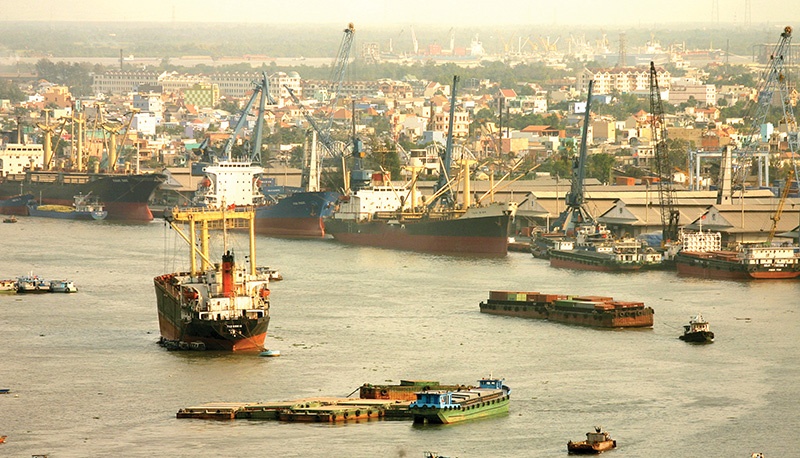Revival hinging on consistency of rules
 |
| Big businesses are adjusting to exporting issues caused this year, Photo: Le Toan |
The ability to control the pandemic and the speed of vaccinations, the pace of the world’s recovery, the government’s supportive policies, and the efforts of businesses in adapting to the changes of the market are the four factors affecting growth in the last months of 2021 and 2022.
Vietnam is focusing on creating the best environment for foreign-invested enterprises in the gradual reopening process. Hayat, the world’s fifth-largest diaper manufacturer, announced its official presence in the Vietnamese market under the Molfix brand. To prepare for this, in 2020, this Turkish group has invested $250 million into a 32-hectare facility in the southern province of Binh Phuoc, with the ambition to capture 30 per cent of the local market by 2025.
Meanwhile, Vietnam is continuing to work on its attractiveness as an investment destination, which will also support Hayat to expand its presence in ASEAN. It is expected that 40 per cent of the factory’s output will be exported to Thailand and Malaysia, where Hayat has invested in trading organisations and companies.
The easing of social distancing has helped economic activities to bustle again. For instance, Vietnam Airlines officially opened ticket sales on October 20 after 11 days of piloting. Now, passengers only need to have a certificate of full vaccination. With many localities easing travel restrictions, Vietnam Airlines plans to restore almost the entire flight network with 40 routes.
Vietnam has also been taking more important steps towards an economic revival. Resolution No.128/NQ-CP recently enacted covers temporary safety regulations and has become a lifesaving solution for businesses operating in the country. The resolution was introduced to eliminate the spread of the virus while allowing businesses to operate effectively.
Although there are no specific guidelines that are uniformly applied throughout the nation, Resolution 128 emphasises local measures in the prevention and control of the pandemic for it to not hinder the movement of goods and production, as well as the movement of people between cities and provinces. This regulation could be very important in helping businesses avoid suspension and supply chain disruption.
With the high level of vaccine coverage among adults in Vietnam, businesses have been able to balance operations while keeping employees safe. The number of vaccinated people has reached a high rate, thereby preventing businesses from closing and limiting losses.
Vietnam’s GDP growth is expected to take up speed again when the market reopens fully. Vietnam may not achieve the target as hoped, but it is still likely to recover growth in the fourth quarter, and more strongly so in 2022.
GDP in the third quarter of 2021 decreased by 6.17 per cent on-year while that of the first nine months increased only 1.42 per cent over the same period last year. In September, the Asian Development Bank lowered Vietnam’s GDP growth forecast for 2021 to 3.8 per cent.
Dr. Nguyen Xuan Thanh from Fulbright University Vietnam said earlier this month, “Multinational corporations will shift production orders for the year-end holiday from Vietnam to other economies if the country does not adapt and open up sustainably. Important industries all decreased in the third quarter, with the processing industry falling by 3.2 per cent, causing challenges for exports in the fourth quarter.”
Thanh found that international organisations remain optimistic, despite lowering the forecast for Vietnam’s economic growth in 2021.
“We need to receive and utilise enough vaccines to reopen normally after our Lunar New Year,” said Thanh, adding that Vietnam needs to stay below a critical rate of seriously ill patients to not overwhelm the healthcare system and open up sustainably.
According to Thanh, monetary policy continued to support the economy, ensuring ample liquidity. To further stimulate growth, “it is necessary to accept a high budget deficit, maybe 6 per cent of GDP, financed by government bonds and a medium-term public investment programme in the next five years,” he added.
Data from the Ministry of Health shows that, by late last week, Vietnam has received nearly 90 million doses of vaccine, with over 70 per cent of the population over 18 age having been vaccinated.
What the stars mean:
★ Poor ★ ★ Promising ★★★ Good ★★★★ Very good ★★★★★ Exceptional
Related Contents
Latest News
More News
- Pivotal stage of growth paves way for rise in M&As (December 03, 2025 | 10:00)
- Positive projections for M&A interest from Thailand (December 03, 2025 | 09:40)
- Manifesting the first line of defence in cybersecurity (December 03, 2025 | 09:00)
- The transformational role AI can play in accounting arena (December 03, 2025 | 08:00)
- Unlocking 5G-AI potential in Singapore (December 03, 2025 | 08:00)
- Data-driven strategies vital for a fast-evolving nation (December 02, 2025 | 09:41)
- Policy to practice: how Vietnam can lead the region (November 26, 2025 | 16:03)
- Mobilising private capital at scale vital for climate battle (November 26, 2025 | 15:36)
- VILAF and Yoon & Yang launch Vietnam - Korea Practice Unit (November 26, 2025 | 15:16)
- Trademark disputes challenge foreign firms in Vietnam (November 24, 2025 | 15:30)

 Tag:
Tag:


















 Mobile Version
Mobile Version